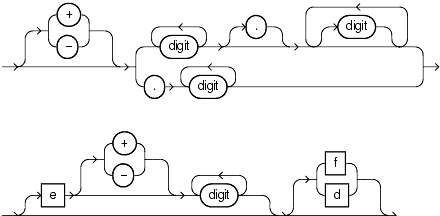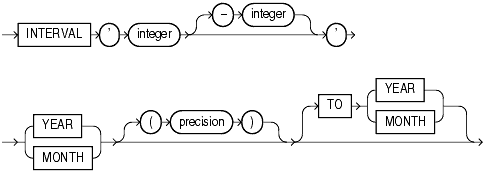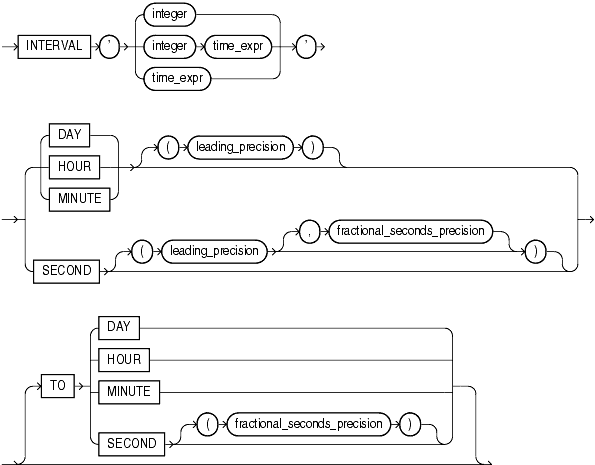| Oracle® Database SQL Reference 10g Release 1 (10.1) Part Number B10759-01 |
|
|
View PDF |
| Oracle® Database SQL Reference 10g Release 1 (10.1) Part Number B10759-01 |
|
|
View PDF |
The terms literal and constant value are synonymous and refer to a fixed data value. For example, 'JACK', 'BLUE ISLAND', and '101' are all character literals; 5001 is a numeric literal. Character literals are enclosed in single quotation marks so that Oracle can distinguish them from schema object names.
This section contains these topics:
Many SQL statements and functions require you to specify character and numeric literal values. You can also specify literals as part of expressions and conditions. You can specify character literals with the 'text' notation, national character literals with the N'text' notation, and numeric literals with the integer, or number notation, depending on the context of the literal. The syntactic forms of these notations appear in the sections that follow.
To specify a datetime or interval datatype as a literal, you must take into account any optional precisions included in the datatypes. Examples of specifying datetime and interval datatypes as literals are provided in the relevant sections of "Datatypes ".
Text specifies a text or character literal. You must use this notation to specify values whenever 'text' or char appear in expressions, conditions, SQL functions, and SQL statements in other parts of this reference. This reference uses the terms text literal and character literal interchangeably.
The syntax of text is as follows:

where
N or n specifies the literal using the national character set. Text entered using this notation is translated into the national character set by Oracle when used.
In the top branch of the syntax:
c is any member of the user's character set. A single quotation mark (') within the literal must be preceded by an escape character. To represent one single quotation mark within a literal, enter two single quotation marks.
' ' are two single quotation marks that begin and end text literals.
In the bottom branch of the syntax:
Q or q indicates that the alternative quoting mechanism will be used. This mechanism allows a wide range of delimiters for the text string.
The outermost ' ' are two single quotation marks that precede and follow, respectively, the opening and closing quote_delimiter.
c is any member of the user's character set. You can include quotation marks (") in the text literal made up of c characters. You can also include the quote_delimiter, as long as it is not immediately followed by a single quotation mark.
quote_delimiter is any single- or multibyte character except space, tab, and return. The quote_delimiter can be a single quotation mark. However, if the quote_delimiter appears in the text literal itself, ensure that it is not immediately followed by a single quotation mark.
If the opening quote_delimiter is one of [, {, <, or (, then the closing quote_delimiter must be the corresponding ], }, >, or ). In all other cases, the opening and closing quote_delimiter must be the same character.
Text literals have properties of both the CHAR and VARCHAR2 datatypes:
Within expressions and conditions, Oracle treats text literals as though they have the datatype CHAR by comparing them using blank-padded comparison semantics.
A text literal can have a maximum length of 4000 bytes.
Here are some valid text literals:
'Hello' 'ORACLE.dbs' 'Jackie''s raincoat' '09-MAR-98' N'nchar literal'
Here are some valid text literals using the alternative quoting mechanism:
q'!name LIKE '%DBMS_%%'!'
q'<'So,' she said, 'It's finished.'>'
q'{SELECT * FROM employees WHERE last_name = 'Smith';}'
nq'ï Ÿ1234 ï'
q'"name like '['"'
Use numeric literal notation to specify fixed and floating-point numbers.
You must use the integer notation to specify an integer whenever integer appears in expressions, conditions, SQL functions, and SQL statements described in other parts of this reference.
The syntax of integer is as follows:

where digit is one of 0, 1, 2, 3, 4, 5, 6, 7, 8, 9.
An integer can store a maximum of 38 digits of precision.
Here are some valid integers:
7 +255
You must use the number or floating-point notation to specify values whenever number or n appears in expressions, conditions, SQL functions, and SQL statements in other parts of this reference.
The syntax of number is as follows:

where
+ or - indicates a positive or negative value. If you omit the sign, then a positive value is the default.
digit is one of 0, 1, 2, 3, 4, 5, 6, 7, 8 or 9.
e or E indicates that the number is specified in scientific notation. The digits after the E specify the exponent. The exponent can range from -130 to 125.
f or F indicates that the number is a 32-bit binary floating point number (of type BINARY_FLOAT).
d or D indicates that the number is a 64-bit binary floating point number (of type BINARY_DOUBLE)
If you omit f or F and d or D, then the number is of type NUMBER.
The suffixes f (F) and d (D) are supported only in floating-point number literals, not in character strings that are to be converted to NUMBER. That is, if Oracle is expecting a NUMBER and it encounters the string '9', then it converts the string to the number 9. However, if Oracle encounters the string '9f', then conversion fails and an error is returned.
A number of type NUMBER can store a maximum of 38 digits of precision. If the literal requires more precision than provided by NUMBER, BINARY_FLOAT, or BINARY_DOUBLE, then Oracle truncates the value. If the range of the literal exceeds the range supported by NUMBER, BINARY_FLOAT, or BINARY_DOUBLE, then Oracle raises an error.
If you have established a decimal character other than a period (.) with the initialization parameter NLS_NUMERIC_CHARACTERS, then you must specify numeric literals with 'text' notation. In these cases, Oracle automatically converts the text literal to a numeric value.
|
Note: You cannot use this notation for floating-point number literals. |
For example, if the NLS_NUMERIC_CHARACTERS parameter specifies a decimal character of comma, specify the number 5.123 as follows:
'5,123'
Here are some valid NUMBER literals:
25 +6.34 0.5 25e-03 -1
Here are some valid floating-point number literals:
25f +6.34F 0.5d -1D
You can also use the following supplied floating-point literals in situations where a value cannot be expressed as a numeric literal:
| Literal | Meaning | Example |
|---|---|---|
binary_float_nan |
A value of type BINARY_FLOAT for which the condition IS NAN is true |
SELECT COUNT(*) FROM employees WHERE TO_BINARY_FLOAT(commission_pct) IS NOT NAN; |
binary_float_infinity |
Single-precision positive infinity |
SELECT COUNT(*) FROM employees WHERE salary < BINARY_FLOAT_INFINITY; |
binary_double_nan |
A value of type BINARY_DOUBLE for which the condition IS NAN is true |
SELECT COUNT(*) FROM employees WHERE TO_BINARY_DOUBLE(commission_pct) IS NOT NAN; |
binary_double_infinity |
Double-precision positive infinity |
SELECT COUNT(*) FROM employees WHERE salary < BINARY_FLOAT_INFINITY; |
An interval literal specifies a period of time. You can specify these differences in terms of years and months, or in terms of days, hours, minutes, and seconds. Oracle Database supports two types of interval literals, YEAR TO MONTH and DAY TO SECOND. Each type contains a leading field and may contain a trailing field. The leading field defines the basic unit of date or time being measured. The trailing field defines the smallest increment of the basic unit being considered. For example, a YEAR TO MONTH interval considers an interval of years to the nearest month. A DAY TO MINUTE interval considers an interval of days to the nearest minute.
If you have date data in numeric form, then you can use the NUMTOYMINTERVAL or NUMTODSINTERVAL conversion function to convert the numeric data into interval values.
Interval literals are used primarily with analytic functions.
|
See Also: "Analytic Functions ", NUMTODSINTERVAL , NUMTOYMINTERVAL , and Oracle Data Warehousing Guide |
Specify YEAR TO MONTH interval literals using the following syntax:

where
'integer [-integer]' specifies integer values for the leading and optional trailing field of the literal. If the leading field is YEAR and the trailing field is MONTH, then the range of integer values for the month field is 0 to 11.
precision is the maximum number of digits in the leading field. The valid range of the leading field precision is 0 to 9 and its default value is 2.
If you specify a trailing field, it must be less significant than the leading field. For example, INTERVAL '0-1' MONTH TO YEAR is not valid.
The following INTERVAL YEAR TO MONTH literal indicates an interval of 123 years, 2 months:
INTERVAL '123-2' YEAR(3) TO MONTH
Examples of the other forms of the literal follow, including some abbreviated versions:
| Form of Interval Literal | Interpretation |
|---|---|
INTERVAL '123-2' YEAR(3) TO MONTH |
An interval of 123 years, 2 months. You must specify the leading field precision if it is greater than the default of 2 digits. |
INTERVAL '123' YEAR(3) |
An interval of 123 years 0 months. |
INTERVAL '300' MONTH(3) |
An interval of 300 months. |
INTERVAL '4' YEAR |
Maps to INTERVAL '4-0' YEAR TO MONTH and indicates 4 years. |
INTERVAL '50' MONTH |
Maps to INTERVAL '4-2' YEAR TO MONTH and indicates 50 months or 4 years 2 months. |
INTERVAL '123' YEAR |
Returns an error, because the default precision is 2, and '123' has 3 digits. |
You can add or subtract one INTERVAL YEAR TO MONTH literal to or from another to yield another INTERVAL YEAR TO MONTH literal. For example:
INTERVAL '5-3' YEAR TO MONTH + INTERVAL'20' MONTH = INTERVAL '6-11' YEAR TO MONTH
Specify DAY TO SECOND interval literals using the following syntax:

where
integer specifies the number of days. If this value contains more digits than the number specified by the leading precision, then Oracle returns an error.
time_expr specifies a time in the format HH[:MI[:SS[.n]]] or MI[:SS[.n]] or SS[.n], where n specifies the fractional part of a second. If n contains more digits than the number specified by fractional_seconds_precision, then n is rounded to the number of digits specified by the fractional_seconds_precision value. You can specify time_expr following an integer and a space only if the leading field is DAY.
leading_precision is the number of digits in the leading field. Accepted values are 0 to 9. The default is 2.
fractional_seconds_precision is the number of digits in the fractional part of the SECOND datetime field. Accepted values are 1 to 9. The default is 6.
If you specify a trailing field, it must be less significant than the leading field. For example, INTERVAL MINUTE TO DAY is not valid. As a result of this restriction, if SECOND is the leading field, the interval literal cannot have any trailing field.
The valid range of values for the trailing field are as follows:
HOUR: 0 to 23
MINUTE: 0 to 59
SECOND: 0 to 59.999999999
Examples of the various forms of INTERVAL DAY TO SECOND literals follow, including some abbreviated versions:
| Form of Interval Literal | Interpretation |
|---|---|
INTERVAL '4 5:12:10.222' DAY TO SECOND(3) |
4 days, 5 hours, 12 minutes, 10 seconds, and 222 thousandths of a second. |
INTERVAL '4 5:12' DAY TO MINUTE |
4 days, 5 hours and 12 minutes. |
INTERVAL '400 5' DAY(3) TO HOUR |
400 days 5 hours. |
INTERVAL '400' DAY(3) |
400 days. |
INTERVAL '11:12:10.2222222' HOUR TO SECOND(7) |
11 hours, 12 minutes, and 10.2222222 seconds. |
INTERVAL '11:20' HOUR TO MINUTE |
11 hours and 20 minutes. |
INTERVAL '10' HOUR |
10 hours. |
INTERVAL '10:22' MINUTE TO SECOND |
10 minutes 22 seconds. |
INTERVAL '10' MINUTE |
10 minutes. |
INTERVAL '4' DAY |
4 days. |
INTERVAL '25' HOUR |
25 hours. |
INTERVAL '40' MINUTE |
40 minutes. |
INTERVAL '120' HOUR(3) |
120 hours |
INTERVAL '30.12345' SECOND(2,4) |
30.1235 seconds. The fractional second '12345' is rounded to '1235' because the precision is 4. |
You can add or subtract one DAY TO SECOND interval literal from another DAY TO SECOND literal. For example.
INTERVAL'20' DAY - INTERVAL'240' HOUR = INTERVAL'10-0' DAY TO SECOND